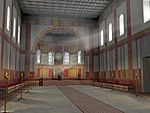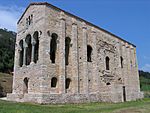Aula regia facts for kids
An aula regia (pronounced: OW-la RAY-jee-uh) is a Latin term that means "royal hall." Think of it as the main, grand hall inside a king's or emperor's palace during the Middle Ages. It was often the most important room, used for big meetings, ceremonies, and receiving important guests. Sometimes, the term "aula regia" was even used to mean the entire royal palace itself, especially a type of imperial palace known as a Kaiserpfalz in German.
Contents
What Was a Royal Hall (Aula Regia)?
The aula regia was the heart of a medieval royal or imperial palace. It was a very large room, designed to impress visitors and show the power of the ruler. These halls were used for many important events:
- Receiving ambassadors from other kingdoms.
- Holding court and making important decisions.
- Feasting and celebrating with nobles and guests.
- Performing official ceremonies.
It was also sometimes called a palas hall. The word palas itself comes from the Latin word for "palace."
Famous Examples of Aula Regias
Many aula regias were built across Europe during the Middle Ages. While some are now ruins, others have been changed over time or even rebuilt.
Santa María del Naranco
One amazing example that still stands today is the church of Santa María del Naranco in Spain, near the city of Oviedo. It was built around the year 850. Originally, it wasn't a church but a royal hall for King Ramiro I. Later, it was turned into a church. Its design shows how grand these halls could be.
The Palace of Aachen
Another important aula regia was part of the Palace of Aachen in Germany. This palace was a favorite residence of Charlemagne, a famous emperor. The royal hall at Aachen later became part of the medieval Town Hall of Aachen. This shows how these old royal buildings were often reused and changed over centuries.
The Imperial Palace at Ingelheim
The Kaiserpfalz (Imperial Palace) at Ingelheim, also in Germany, had a very impressive aula regia. Today, only parts of it remain. However, experts have used technology to create digital reconstructions. These computer graphics help us imagine what the hall looked like when it was new, with its grand architecture and decorations.
The Roman Influence: Aula Palatina
The architectural style for many of these medieval royal halls was inspired by much older Roman buildings. A key example is the Aula Palatina (also known as the Basilica of Constantine) in Trier, Germany. This huge Roman hall was built around 310 AD for the Roman Emperor Constantine. Its massive size and grand design served as a model for later medieval aula regias.
The Aula Regia in Ancient Rome
The term Aula Regia was also used in ancient Rome. For example, the main reception room in the Domus Flavia was called the Aula Regia. The Domus Flavia was a huge palace built by Emperor Domitian on the Palatine Hill in Rome. This shows that the idea of a grand "royal hall" for official business goes back a very long time.
See also
 In Spanish: Aula regia para niños
In Spanish: Aula regia para niños





